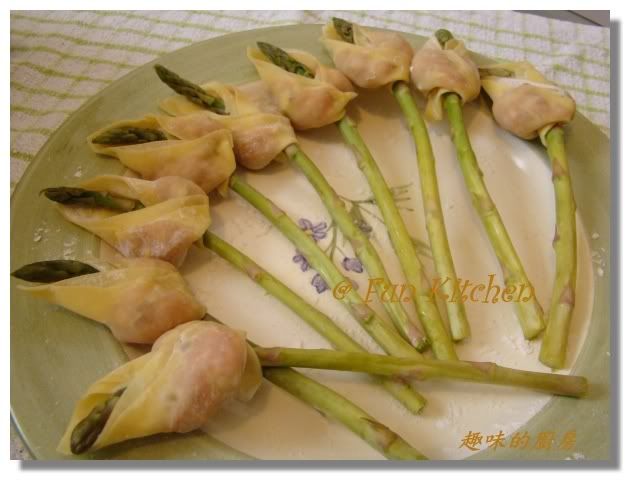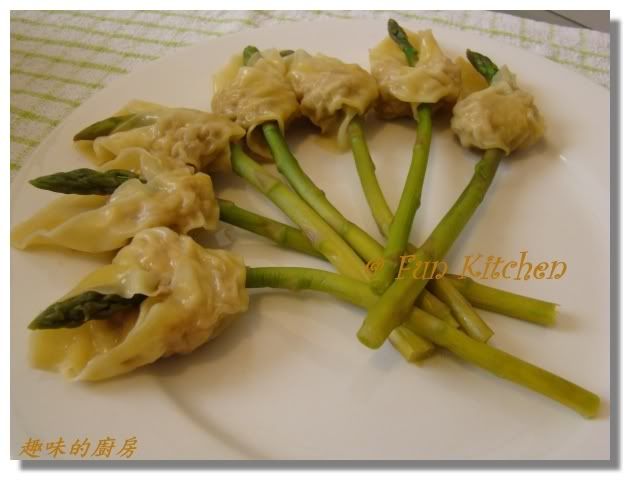
海芋扁食(餛飩)
Calla Won Ton (dumplings)
Hái-ō͘ hoa hêng ê pián-sit
Basically, it is ‘won ton’ and in Taiwanese, we call them ‘pián-si̍t’. However, with creativity, we reshape the dumplings and make them look like callas. I once watched a TV programme in Taiwan, in which it talked about how a mother thought up this creative idea to encourage her children to eat vegetable. Later, she developed this idea as her small business, selling calla won ton through Internet. I always want to try and never made it till I find a blog, in which another Taiwanese mother sharing her experience about making calla won ton with her children and in which she instructs the audience how to make won ton into calla shape. Following her guidance, it’s my turn.
The ingredients we need for 20 beautiful calla pián-si̍t (won ton) are listed below:
For the filling:
100g, pork mince
2 tbsp dried shallot flakes
Salt and white pepper powder
For calla pián-si̍t (won ton)
20 pieces of (square) won ton pastry
20 sticks of asparagus, washed and trimmed
For dipping sauce (optional)
2-3 thin slices of ginger, shredded
1 tbsp white wine vinegar
1 tsp sesame oil
1-2 tbsp soy sauce
Step-by-Step:
1. Mix the filling: put pork mince and dried shallot flakes in a bowl and mix them well and then season the filling with salt and white pepper powder.
2. Make the calla: (the most difficult part of the dish)
a. Take one piece of square won ton pastry; spread the filling flat on the pastry
b. Fold the pastry in a triangle shape; place the tip of the triangle upright and place the head of the asparagus spear in the centre of the triangle won ton.
c. Fold the left side to the right and then fold the right side to the left, wrapping around the asparagus stalk; fix the peaks on the back side (if needed, use some water to glue the pastry)
3. Put the calla won ton in a pot of boiling water and with medium heat cook for around 3 minutes or less. (don’t over cook them, the pastry softens very quickly)
4. Mix the dipping sauce: simply put ingredients all together and mix well.
5. Bon appetite!

(台羅文)
Goá ū chi̍t-ê koài-phiah, tio̍h-sī ài chiah ū pau āⁿ ê mi̍h-kiāⁿ(si̍t-bu̍t), chhiūⁿ bah-oân, chúi-kiáu, gio-za (gyoza/chian-kiáu), tong-jiân iah-koh-ū pián-si̍t. Téng-kang tī Tâi-oân khoàⁿ tiān-sī kong ū chi̍t-ê ma-ma kā pián-si̍t choe seng hái-ō͘ hoa ê chō-hêng lâi hō͘ i-ê kín-á ē ài chiah so͘-chhài. Lî-chhiáⁿ, koh hoat-tian kàu iōng bāng-lō͘ choe seng-lí lâi chhù phoè pián-si̍t. It-ti̍t liām kong beh kap gún a-bú chhoē chi̍t-kang kà-ji̍t lai chhì-bāi. Liām kúi-nā kô goe̍h, siuⁿ kè pîn-toāⁿ long m̄-bat si̍t-hiān. Hit-kang, siong-tioh, hèng-chhì-chhì, má-siōng chhoē bāng-lō͘, oh choè-hoat, cheng kúi-kang boé tioh pián-si̍t phoê tioh kā-i chhì-choe chhut lai lo.
Í-hā ê hūn-liōng sī ē-tàng choe 20 ki hái-ō͘ pián-si̍t ê chhâi-liāu:
āⁿ:
100g ê tu-bah, ká-bah
2 toa-thng-sî ê iû-chhang
Iâm kap peh hô͘-chio hún
Pián-si̍t ê pō͘-hūn:
20 tiuⁿ pián-si̍t phoê
20 ki lô͘-sún, soé-kè, kián kè
Ùn-liau:
Kiuⁿ-si
1 toa-thng-sî ê peh chhò͘
1 sè-thng-sî ê moâ-iû
1-2 toa-thng-sî ê tāu-iû
choè-hoat:
1. Tu-bah kap iû-chhang khǹg leh toa-oáⁿ, lām ho͘ chiâu-ûn, ka iâm kap peh hô͘-chio-hún chhiám kiâm tiⁿ.
2. Pau choe hái-ō͘ ê hêng: siōng khùn-lân ê pō͘-hūn
a. Theh chi̍t tiuⁿ pián-si̍t phoê, boah āⁿ tī bīn-téng
b. pián-si̍t phoê tùi-áu choe saⁿ-kak hêng (nn̄g pêng kâng-khoáⁿ tn̂g), khǹg chi̍t ki lô͘-sún tī pián-si̍t ê tiong-ng, lô͘-sún hoe hiòng saⁿ-kak-hêng ê chiam-kak.
c. Tò-pêng ê kak pau kè-lâi chiàⁿ-pêng, boah chi̍t-tiám-á chúi liâm leh āu-pêng, chiàⁿ-pêng ê kak pau kè-lâi tò-pêng, boah chi̍t-tiám-á chúi liâm leh āu-pêng.
3. Iōng kún-chúi sa̍h pián-si̍t; mài sa̍h siōng kú, pián-si̍t phoê ē kô͘ khì
4. Ùn-liau lām hó.
5. Sio kiaⁿ hiông!
(漢羅)
我有一個怪癖, 著是愛食有包餡的物件(食物), 像肉圓, 水餃, gio-za(gyoza/煎餃), 當然益閣有扁食. 頂工佇台灣看電視講有一個媽媽kā扁食做成海芋的造形來予伊的囝仔會愛食蔬菜. 而且, 閣發展到用網路做生理(生意)來厝配(宅配)扁食. 一直唸講欲及阮阿母尋一工(找一天)假日來試bāi(試試看). 唸幾若個月, siuⁿ過貧惰(太過懶惰)攏毋捌(未曾)實現. 彼工, 想著, 興熾熾, 馬上尋網路, 學做法, 前幾工買著扁食皮著kā伊試做出來囉.
以下的份量是會當做20枝海芋扁食的材料:
餡:
100g的豬肉, 絞肉
2大湯匙的油蔥
鹽及白胡椒粉
扁食的部份:
20張 扁食皮
20枝 蘆筍, 洗過, 撿過
搵料:
薑絲
1大湯匙的白chhò͘
1細湯匙的麻油
1-2大湯匙的豆油
做法:
1. 豬肉及油蔥khǹg leh大碗, lām乎齊勻, 加鹽及白胡椒粉
2. 包做海芋的形: 尚困難的部份
a. 提一張扁食皮, 抹餡佇面頂
b. 扁食皮對拗做三角形 (兩爿仝款長), khǹg一枝蘆筍佇扁食的中央, 蘆筍花向三角形的尖角.
c. 倒爿的角包過來正爿, 抹一點仔水粘leh後爿, 正爿的角包過來倒爿, 抹一點仔水粘leh後爿.
3. 用滾水煠扁食; 勿煠尚久, 扁食皮會糊去.
4. 搵料lām好.
5. 燒驚狠!

問: 請問大家家裡也會講【燒驚狠】(Sio kiaⁿ hiông!)嗎? 在我家,我媽媽會這樣說耶,每次她煮好熱騰騰的食物,咕嚕咕嚕吃下去,可是很燙,她就會說Sio kiaⁿ hiông!不過,外國有研究說,還是不要吃太燙的食物,對食道不好唷!


 留言列表
留言列表
